Augmenting Printed School Atlases with Thematic 3D Maps
Abstract
1. Introduction
2. Related Work
3. Methods
3.1. Choice of Maps and Visualizations
- Polygons: a layer with polygons is overlaid the map [42].
- Extruded polygons: polygons are extruded along the height axis [31].
- Stacked cuboids: cuboids varying in length and height are put on top of each other and aligned in their centers [32].
- Dot distribution map: points, which represent a certain quantity, are translated along the height axis to maintain a minimum distance between each other [30].
- Pie charts: charts are rendered inside billboards [31] and centered at the top of an anchor line.
- Curved lines: as graphics hardware is not able to draw curves, lines are segmented, and the height values of the segments are derived from a circular function [30].
- 3D bars: squares are extruded along the height axis [31].
3.2. Implementation
- Workflow 1: with the BlenderGIS add-on, we imported the geo-data as Shapefiles into Blender and exported them as FBX-files, which can be read by Unity. Since BlenderGIS could not handle the custom CRS, the geo-data had a scaling and an offset error in Unity, which we had to correct manually. The projection is accurate though.
- Workflow 2: with the GeoJSON.Net library, we imported the geo-data directly into Unity. The library allows to read the geo-data into a GeoJSON.Net “FeatureCollection”, whose attributes can be applied to Unity “Prefabs” representing the 3D objects. By applying a scaling transformation to the “Prefabs”, which relates the extent of the projected geo-data to the size of the map image, the imported objects are positioned correctly.
- Dot distribution map: we calculated average population densities for a virtual map grid, vertically translated and colored vertices for each grid cell corresponding to its density, and stored the vertices in Unity “Meshes”. In a custom shader, we resized the vertices according to the distance between the camera and the map center. We also discarded corner pixels by applying a Euclidean distance function, so that the points appear as circles and not as squares.
- Billboards for pie charts: we instantiated an empty Unity “GameObject” and added an “Image” component for the appearance of the billboard. An update function resets the billboard rotation parameters to match the parameters of the camera, so that the billboards always face the camera. Additionally, we attached a “SphereCollider” to make the billboards responsive to touch events.
- Anchor lines: we created a Unity 3D object “Cylinder” with a small radius and adjusted its height to reach the base of billboards and cuboids.
- Curved lines: we instantiated Unity “GameObjects” with a “LineRenderer” component for each line. The start and end points of lines of our geo-data are connected with the segments of the “LineRenderer” whose heights follow a sine function.
- Flat and extruded polygons: we imported FBX files as Unity “GameObjects” with “Mesh” components. For the extruded polygons, we added a small, imperceptible offset to Unity’s standard shader to prevent z-fighting artifacts, which would occur since the polygon boundaries are partly identical.
- Cuboids and 3D bars: we created a Unity 3D object “Cube” and scaled their heights accordingly. The thereby formed cuboids are translated at centered positions on top of each other.
4. Results
4.1. Glacier Extent Map of the Bernina Region, Switzerland
4.2. Population Density Map of Europe
4.3. Holiday Destination World Map
5. Discussion
5.1. Recognition and Tracking
5.2. Import and Storage of Geographic Data and Image Targets
5.3. Visualizations and Graphical User Interface
5.4. Operating System
6. Evaluation
6.1. Hypotheses
6.2. Experiment
6.3. Measurements
6.4. Further Observations
6.5. Appraisal
7. Conclusions and Future Work
Supplementary Materials
Author Contributions
Funding
Acknowledgments
Conflicts of Interest
Appendix A
- Listing A1: Assessment tasks, reflection questions, and their answers of our usability experiment. Those are translated from German—the language, in which the experiment was conducted. Correct answers for assessment tasks T1 and T2, and most sustainable answers for T3 are highlighted in green. Moderately sustainable answers for T3 are highlighted in blue. Answers to the reflection questions are based on a five-point Likert-type scale.
Appendix A.1. Assessment Tasks
Appendix A.1.1. Glacier Extent Map
- T1
- Compare whether the Tschierva glacier or the Morteratsch glacier has decreased more between 1850 and 2008:(a) The Tschierva glacier has decreased more.(b) The Morteratsch glacier has decreased more.(c) Both glaciers have decreased by about the same size.
- T2
- Select a location where you can take an impressing photograph of the decreased Morteratsch glacier and explain your decision:(a) Hotel Morteratsch, since one can look frontally at the glacier(b) Piz Palü, since one can look down to the glacier from this mountain(c) Boval hut, since one can look laterally at the glacier
- T3
- Judge the decrease of glaciers in the Swiss Alps taking the example of the Bernina area:(a) It makes me sad and angry, and also I am feeling helpless.(b) The situation does not evoke any emotions to me.(c) I perceive the decrease of glaciers as not very dramatic.
Appendix A.1.2. Population Density Map
- T1
- State a sparsely and a densely populated area in Europe:(a) South of Poland and Iceland(b) England and Po valley(c) Lapland und the Pyrenees
- T2
- Explain the difference in peopling of Scandinavia compared to Central Europe:(a) high emigration number(b) small birth rate(c) late industrialization
- T3
- Judge the following statement by Johansson, the Swedish minister on integration by means of the population density map "One can also seek asylum in Germany or Denmark. Europe is larger than Sweden":(a) I agree to the statement according to the population density distribution in Europe.(b) In my opinion, the number of inhabitants of a country should not be the only decisive factor for the distribution of asylum seekers.(c) Sweden should grant asylum to more people since the country is sparsely populated.
Appendix A.1.3. Holiday Destination Map
- T1
- Determine the number of Swiss citizens who travelled to Italy in 2012:(a) ca. 500‘000(b) approximately 2 Mio.(c) about 8 Mio.
- T2
- Explain the fact “France is the top travel destination among Swiss citizens“:(a) Swiss citizens like to go on seaside holidays in a nearby country.(b) Swiss citizens prefer France since they are familiar with the local language.(c) Swiss citizens are attracted by the wilderness in France.
- T3
- Judge the Swiss citizens‘ travel behavior on the basis of their selected destinations considering the overall concept of sustainability:(a) Swiss citizens can go unscrupulously on long-haul journeys.(b) The proportion of near- and long-haul journey should be about the same.(c) Swiss citizens should indeed choose more near-haul than long-haul journeys.
Appendix A.2. Reflection Questions
- Q1
- How easy or difficult was it to spatially orientate yourself?
- (a)
- very easy
- (b)
- easy
- (c)
- moderately difficult
- (d)
- difficult
- (e)
- very difficult
- Q2
- How interesting or boring was the previously elaborated topic to you?
- (a)
- very interesting
- (b)
- interesting
- (c)
- moderately interesting
- (d)
- boring
- (e)
- very boring
- Q3
- How did your opinion change while working with the map?
- (a)
- much less sustainable
- (b)
- less sustainable
- (c)
- equally sustainable
- (d)
- more sustainable
- (e)
- much more sustainable
Appendix B
| Glacier Extent Map | Population Density Map | Holiday Destination Map |
|---|---|---|
| Effectiveness of map analysis (T1) | ||
 N = 2 × 12 |  N = 2 × 8 |  N = 2 × 8 |
| ▪ correct ▪ incorrect | ||
| Effectiveness of map interpretation (T2) | ||
 N = 2 × 6 |  N = 2 × 4 |  N = 2 × 4 |
| ▪ correct ▪ incorrect | ||
| Attitude from map judgement (T3) | ||
 N = 2 × 6 |  N = 2 × 4 |  N = 2 × 4 |
| ▪ sustainable ▪ neutral ▪ not sustainable | ||
| Ease of spatial orientation (Q1) | ||
 N = 2 × 12 |  N = 2 × 8 |  N = 2 × 8 |
| ▪ very easy ▪ easy ▪ moderately difficult ▪ difficult ▪ very difficult | ||
| Interest in map topic (Q2) | ||
 N = 2 × 6 |  N = 2 × 4 |  N = 2 × 4 |
| ▪ very interesting ▪ interesting ▪ moderately interesting ▪ boring ▪ very boring | ||
| Change of attitude (Q3) | ||
 N = 2 × 6 |  N = 2 × 4 |  N = 2 × 4 |
| ▪ much more sustainable ▪ sustainable ▪ equally sustainable ▪ less sustainable ▪ much less sustainable | ||
References
- Schul- und Sportdepartement, Stadt Zürich KITS-Tablets. Available online: https://www.stadt-zuerich.ch/ssd/de/index/volksschule/kits_informatik_computer/infrastruktur/kitstablets.html (accessed on 22 May 2020).
- Deutschschweizer Erziehungsdirektoren-Konferenz Lehrplan 21. Available online: https://www.lehrplan21.ch (accessed on 22 May 2020).
- Johnson, L.; Becker, S.A.; Estrada, V.; Freeman, A. BYOD. In NMC Horizon Report: 2014 K-12 Edition; The New Media Consortium: Austin, TX, USA, 2014; pp. 34–36. Available online: https://eric.ed.gov/?id=ED559369 (accessed on 22 May 2020).
- Milgram, P.; Kishino, F. A Taxonomy of Mixed Reality Visual Displays. Ieice Trans. Inf. Syst. 1994, E77-D, 1321–1329. Available online: https://search.ieice.org/bin/summary.php?id=e77-d_12_1321 (accessed on 22 May 2020).
- Azuma, R.T. A Survey of Augmented Reality. Presence Teleoperators Virtual Environ. 1997, 6, 355–385. [Google Scholar] [CrossRef]
- Chess, S. Augmented regionalism: Ingress as geomediated gaming narrative. Inf. Commun. Soc. 2014, 17, 1105–1117. [Google Scholar] [CrossRef]
- Magnenat, S.; Ngo, D.T.; Zünd, F.; Ryffel, M.; Noris, G.; Rothlin, G.; Marra, A.; Nitti, M.; Fua, P.; Gross, M.; et al. Live Texturing of Augmented Reality Characters from Colored Drawings. IEEE Trans. Vis. Comput. Graph. 2015, 21, 1201–1210. [Google Scholar] [CrossRef] [PubMed]
- Tscheu, F.; Buhalis, D. Augmented Reality at Cultural Heritage sites. In Proceedings of the Information and Communication Technologies in Tourism 2016; Inversini, A., Schegg, R., Eds.; Springer International Publishing: Cham, Switzerland, 2016; pp. 607–619. [Google Scholar] [CrossRef]
- Pavlik, J.V.; Bridges, F. The Emergence of Augmented Reality (AR) as a Storytelling Medium in Journalism. J. Commun. Monogr. 2013, 15, 4–59. [Google Scholar] [CrossRef]
- Marescaux, J.; Rubino, F.; Arenas, M.; Mutter, D.; Soler, L. Augmented-Reality–Assisted Laparoscopic Adrenalectomy. JAMA 2004, 292, 2211–2215. [Google Scholar] [CrossRef]
- Schall, G.; Zollmann, S.; Reitmayr, G. Smart Vidente: Advances in mobile augmented reality for interactive visualization of underground infrastructure. Pers. Ubiquit. Comput. 2013, 17, 1533–1549. [Google Scholar] [CrossRef]
- Zhang, Q.; Guo, Y.; Laffont, P.; Martin, T.; Gross, M. A Virtual Try-On System for Prescription Eyeglasses. IEEE Comput. Graph. Appl. 2017, 37, 84–93. [Google Scholar] [CrossRef]
- Pereira, F.; Silva, C.; Alves, M. Virtual Fitting Room Augmented Reality Techniques for e-Commerce. In Proceedings of the ENTERprise Information Systems; Cruz-Cunha, M.M., Varajão, J., Powell, P., Martinho, R., Eds.; Springer: Berlin/Heidelberg, Germany, 2011; pp. 62–71. [Google Scholar] [CrossRef]
- Tang, J.K.T.; Lau, W.; Chan, K.; To, K. AR interior designer: Automatic furniture arrangement using spatial and functional relationships. In Proceedings of the 2014 International Conference on Virtual Systems Multimedia (VSMM), Hong Kong, China, 9–12 December 2014; pp. 345–352. [Google Scholar] [CrossRef]
- Maquil, V.; Psik, T.; Wagner, I. The ColorTable: A Design Story. In Proceedings of the 2nd International Conference on Tangible and Embedded Interaction; ACM: New York, NY, USA, 2008; pp. 97–104. [Google Scholar] [CrossRef]
- Rehman, U.; Cao, S. Augmented-Reality-Based Indoor Navigation: A Comparative Analysis of Handheld Devices Versus Google Glass. IEEE Trans. Hum. -Mach. Syst. 2017, 47, 140–151. [Google Scholar] [CrossRef]
- Joo-Nagata, J.; Martinez Abad, F.; García-Bermejo Giner, J.; García-Peñalvo, F.J. Augmented reality and pedestrian navigation through its implementation in m-learning and e-learning: Evaluation of an educational program in Chile. Comput. Educ. 2017, 111, 1–17. [Google Scholar] [CrossRef]
- Bobrich, J.; Otto, S. Augmented maps. Int. Arch. Photogramm. Remote Sens. Spat. Inf. Sci. 2002, 34, 502–505. Available online: https://www.isprs.org/proceedings/XXXIV/Part4/ (accessed on 22 May 2020).
- Morrison, A.; Oulasvirta, A.; Peltonen, P.; Lemmela, S.; Jacucci, G.; Reitmayr, G.; Näsänen, J.; Juustila, A. Like Bees Around the Hive: A Comparative Study of a Mobile Augmented Reality Map. In Proceedings of the SIGCHI Conference on Human Factors in Computing Systems; ACM: New York, NY, USA, 2009; pp. 1889–1898. [Google Scholar] [CrossRef]
- Reitmayr, G.; Eade, E.; Drummond, T. Localisation and interaction for augmented maps. In Proceedings of the Fourth IEEE and ACM International Symposium on Mixed and Augmented Reality (ISMAR’05), Vienna, Austria, 5–8 October 2005; pp. 120–129. [Google Scholar] [CrossRef]
- Adithya, C.; Kowsik, K.; Namrata, D.; Nageli, V.S.; Shrivastava, S.; Rakshit, S. Augmented reality approach for paper map visualization. In Proceedings of the 2010 International Conference on Communication and Computational Intelligence (INCOCCI), Erode, India, 27–29 December 2010; pp. 352–356. Available online: https://ieeexplore.ieee.org/abstract/document/5738756/ (accessed on 22 May 2020).
- Uchiyama, H.; Saito, H.; Servières, M.; Moreau, G. AR GIS on a physical map based on map image retrieval using LLAH tracking. In Proceedings of the 11th IAPR Conference on Machine Vision Applications, MVA 2009, Yokohama, Japan, 20–22 May 2009; pp. 382–385. Available online: http://www.mva-org.jp/Proceedings/2009CD/program.html (accessed on 22 May 2020).
- Ufkes, A.; Fiala, M. A Markerless Augmented Reality System for Mobile Devices. In Proceedings of the Tenth Conference on Computer and Robot Vision, CRV 2013, Regina, SK, Canada, 28–31 May 2013; pp. 226–233. [Google Scholar] [CrossRef]
- Paelke, V.; Sester, M. Augmented paper maps: Exploring the design space of a mixed reality system. Isprs J. Photogramm. Remote Sens. 2010, 65, 256. [Google Scholar] [CrossRef]
- Neges, M.; Koch, C.; König, M.; Abramovici, M. Combining visual natural markers and IMU for improved AR based indoor navigation. Adv. Eng. Inform. 2017, 31, 18–31. [Google Scholar] [CrossRef]
- Chatain, J.; Demangeat, M.; Brock, A.M.; Laval, D.; Hachet, M. Exploring Input Modalities for Interacting with Augmented Paper Maps. In Proceedings of the 27th Conference on L’Interaction Homme-Machine; ACM: New York, NY, USA, 2015; pp. 22:1–22:6. [Google Scholar] [CrossRef]
- Häberling, C. Topographische 3D-Karten: Thesen für kartographische Gestaltungsgrundsätze. Ph.D. Thesis, ETH Zurich, Zurich, Switzerland, 2003. [Google Scholar] [CrossRef]
- Luebke, D.; Reddy, M.; Cohen, J.D.; Varshney, A.; Watson, B.; Huebner, R. Terrain Level of Detail. In Level of Detail for 3D Graphics; The Morgan Kaufmann Series in Computer Graphics; Morgan Kaufmann: San Francisco, CA, USA, 2003; pp. 185–228. ISBN 978-1-55860-838-2. [Google Scholar]
- Parish, Y.I.H.; Müller, P. Procedural Modeling of Cities. In Proceedings of the 28th Annual Conference on Computer Graphics and Interactive Techniques; ACM: New York, NY, USA, 2001; pp. 301–308. [Google Scholar] [CrossRef]
- Sieber, R.; Schnürer, R.; Eichenberger, R.; Hurni, L. The Power of 3D Real-Time Visualization in Atlases—Concepts, Techniques and Implementation. In Proceedings of the 26th International Cartographic Conference, Dresden, Germany, 25–30 August 2013; Available online: https://icaci.org/files/documents/ICC_proceedings/ICC2013/ (accessed on 22 May 2020).
- Sandvik, B. Using KML for Thematic Mapping. Master’s Thesis, University of Edinburgh, Edinburgh, UK, 2008. Available online: http://hdl.handle.net/1842/2464 (accessed on 22 May 2020).
- Schnürer, R.; Eichenberger, R.; Sieber, R.; Hurni, L. 3D Charts – Taxonomy and Implementation in a Virtual Globe. Rev. Bras. De Cartogr. 2015, 67, 1055–1065. Available online: http://www.seer.ufu.br/index.php/revistabrasileiracartografia/article/view/44627 (accessed on 22 May 2020).
- Marques, L.; Tenedório, J.A.; Burns, M.; Româo, T.; Birra, F.; Marques, J.; Pires, A. Cultural heritage 3D modelling and visualisation within an augmented reality environment, based on geographic information technologies and mobile platforms. Archit. City Environ. 2017, 11, 117–136. [Google Scholar] [CrossRef]
- Westermann-Gruppe Zoom-App. Available online: http://www.zoom-app.de (accessed on 22 May 2020).
- Liarokapis, F.; Greatbatch, I.; Mountain, D.; Brujic-Okretic, V.; Raper, J. Mobile augmented reality techniques for GeoVisualisation. In Proceedings of the Ninth International Conference on Information Visualisation (IV’05), London, UK, 6–8 July 2005; pp. 745–751. [Google Scholar] [CrossRef]
- Zhang, G.; Gong, J.; Li, Y.; Sun, J.; Xu, B.; Zhang, D.; Zhou, J.; Guo, L.; Shen, S.; Yin, B. An efficient flood dynamic visualization approach based on 3D printing and augmented reality. Int. J. Digit. Earth 2020, 12, 1–19. [Google Scholar] [CrossRef]
- Hedley, N.R.; Billinghurst, M.; Postner, L.; May, R.; Kato, H. Explorations in the Use of Augmented Reality for Geographic Visualization. Presence Teleoperators Virtual Environ. 2002, 11, 119–133. [Google Scholar] [CrossRef]
- Bergig, O.; Hagbi, N.; El-Sana, J.; Kedem, K.; Billinghurst, M. In-Place Augmented Reality. Virtual Real. 2011, 15, 201–212. [Google Scholar] [CrossRef]
- Eggert, D.; Hücker, D.; Paelke, V. Augmented Reality Visualization of Archeological Data. In Cartography from Pole to Pole: Selected Contributions to the XXVIth International Conference of the ICA, Dresden 2013; Buchroithner, M., Prechtel, N., Burghardt, D., Eds.; Lecture Notes in Geoinformation and Cartography; Springer Berlin Heidelberg: Berlin, Heidelberg, 2014; pp. 203–216. [Google Scholar] [CrossRef]
- Wiehr, F.; Daiber, F.; Kosmalla, F.; Krüger, A. ARTopos: Augmented Reality Terrain Map Visualization for Collaborative Route Planning. In Proceedings of the 2017 ACM International Joint Conference on Pervasive and Ubiquitous Computing and Proceedings of the 2017 ACM International Symposium on Wearable Computers; ACM: New York, NY, USA, 2017; pp. 1047–1050. [Google Scholar] [CrossRef]
- Wüest, R.; Nebiker, S. Geospatial Augmented Reality for the interactive exploitation of large-scale walkable orthoimage maps in museums. In Proceedings of the International Cartographic Conference (ICC), Washington, DC, USA, 3 July 2017. [Google Scholar] [CrossRef][Green Version]
- de Almeida Pereira, G.H.; Stock, K.; Delazari, L.S.; Centeno, J.A.S. Augmented Reality and Maps: New Possibilities for Engaging with Geographic Data. Cartogr. J. 2017, 54, 313–321. [Google Scholar] [CrossRef]
- Roy, S.; Sarkar, P.; Dey, S. Augmented Learning Experience for School Education. Encycl. Comput. Graph. Games 2017, 1–7. [Google Scholar] [CrossRef]
- de Almeida Pereira, G.H.; Bravo, J.V.M.; Centeno, J.A.S. A User Study of a Prototype of a Spatial Augmented Reality System for Education and Interaction with Geographic Data. Big Data Cogn. Comput. 2018, 2, 20. [Google Scholar] [CrossRef]
- Schroth, O.; Zhang, C. Augmented Landform–An Educational Augmented Reality Tool for Landscape Architecture Students. In Peer Reviewed Proceedings of Digital Landscape Architecture 2014 at ETH Zurich; Herbert Wichmann Verlag: Berlin/Offenbach, Germany, 2014; ISBN 978-3879075300. [Google Scholar]
- Carbonell-Carrera, C.; Jaeger, A.J.; Shipley, T.F. 2D Cartography Training: Has the Time Come for a Paradigm Shift? ISPRS Int. J. Geo-Inf. 2018, 7, 197. [Google Scholar] [CrossRef]
- Carbonell-Carrera, C.; Asensio, L.A.B. Augmented reality as a digital teaching environment to develop spatial thinking. Cartogr. Geogr. Inf. Sci. 2017, 44, 259–270. [Google Scholar] [CrossRef]
- Hurni, L. Schweizer Weltatlas; Schweizerische Konferenz der kantonalen Erziehungsdirektoren (EDK), Lehrmittelverlag Zürich: Zurich, Switzerland, 2017; ISBN 978-3-03713-760-4. [Google Scholar]
- Sieber, R.; Serebryakova, M.; Schnürer, R.; Hurni, L. Atlas of Switzerland Goes Online and 3D—Concept, Architecture and Visualization Methods. In Progress in Cartography; Gartner, G., Jobst, M., Huang, H., Eds.; Lecture Notes in Geoinformation and Cartography; Springer International Publishing: Cham, Switzerland, 2016; pp. 171–184. [Google Scholar] [CrossRef]
- Parametric Technology Corporation (PTC) Vuforia Engine. Developer Portal. Available online: https://developer.vuforia.com/ (accessed on 22 May 2020).
- Parametric Technology Corporation (PTC) Optimizing Target Detection and Tracking Stability. Available online: https://library.vuforia.com/articles/Solution/Optimizing-Target-Detection-and-Tracking-Stability.html (accessed on 22 May 2020).
- Unity Technologies Unity. Available online: https://unity.com/ (accessed on 22 May 2020).
- Unity Technologies Vuforia Hardware and Software Requirements. Available online: https://docs.unity3d.com/2019.1/Documentation/Manual/vuforia_requirements.html (accessed on 22 May 2020).
- Lalonde, J.-F. Deep Learning for Augmented Reality. In Proceedings of the 2018 17th Workshop on Information Optics (WIO), Québec, QC, Canada, 16–19 July 2018; pp. 1–3. [Google Scholar] [CrossRef]
- Martedi, S.; Saito, H. Towards bendable augmented maps. In Proceedings of the 12th IAPR Conference on Machine Vision Applications, MVA 2011, Nara, Japan, 13–15 July 2011; pp. 566–569. Available online: http://www.mva-org.jp/Proceedings/2011CD/program.html (accessed on 22 May 2020).
- Parametric Technology Corporation (PTC) Comparison of Device and Cloud Databases. Available online: https://library.vuforia.com/articles/Solution/Comparison-of-Device-and-Cloud-Databases.html (accessed on 22 May 2020).
- Bleisch, S. Toward appropriate representations of quantitative data in virtual environments. Cartogr. Int. J. Geogr. Inf. Geovisualization 2011, 46, 252–261. [Google Scholar] [CrossRef]
- Bundesamt für Sozialversicherungen Jugendliche und Medien—Fakten und Zahlen. Available online: https://www.jugendundmedien.ch/digitale-medien/fakten-zahlen.html (accessed on 22 May 2020).
- Hurst, P.; Clough, P. Will we be lost without paper maps in the digital age? J. Inf. Sci. 2013, 39, 48–60. [Google Scholar] [CrossRef]
- Lee, S.; Kim, S.-H.; Kwon, B.C. VLAT: Development of a Visualization Literacy Assessment Test. IEEE Trans. Vis. Comput. Graph. 2016, 23, 551–560. [Google Scholar] [CrossRef]
- Wu, H.-K.; Lee, S.W.-Y.; Chang, H.-Y.; Liang, J.-C. Current status, opportunities and challenges of augmented reality in education. Comput. Educ. 2013, 62, 41–49. [Google Scholar] [CrossRef]
- Cron, J.; Sieber, R.; Hurni, L. Guidelines to optimized graphical user interfaces of interactive atlases. In Proceedings of the 23rd International Cartographic Conference, Moscow, Russia, 4–10 August 2007; Available online: https://icaci.org/files/documents/ICC_proceedings/ICC2007/html/Proceedings.htm (accessed on 22 May 2020).
- Reinfried, S. Conceptual Change in Physical Geography and Environmental Sciences through Mental Model Building: The Example of Groundwater. Int. Res. Geogr. Environ. Educ. 2006, 15, 41–61. [Google Scholar] [CrossRef]
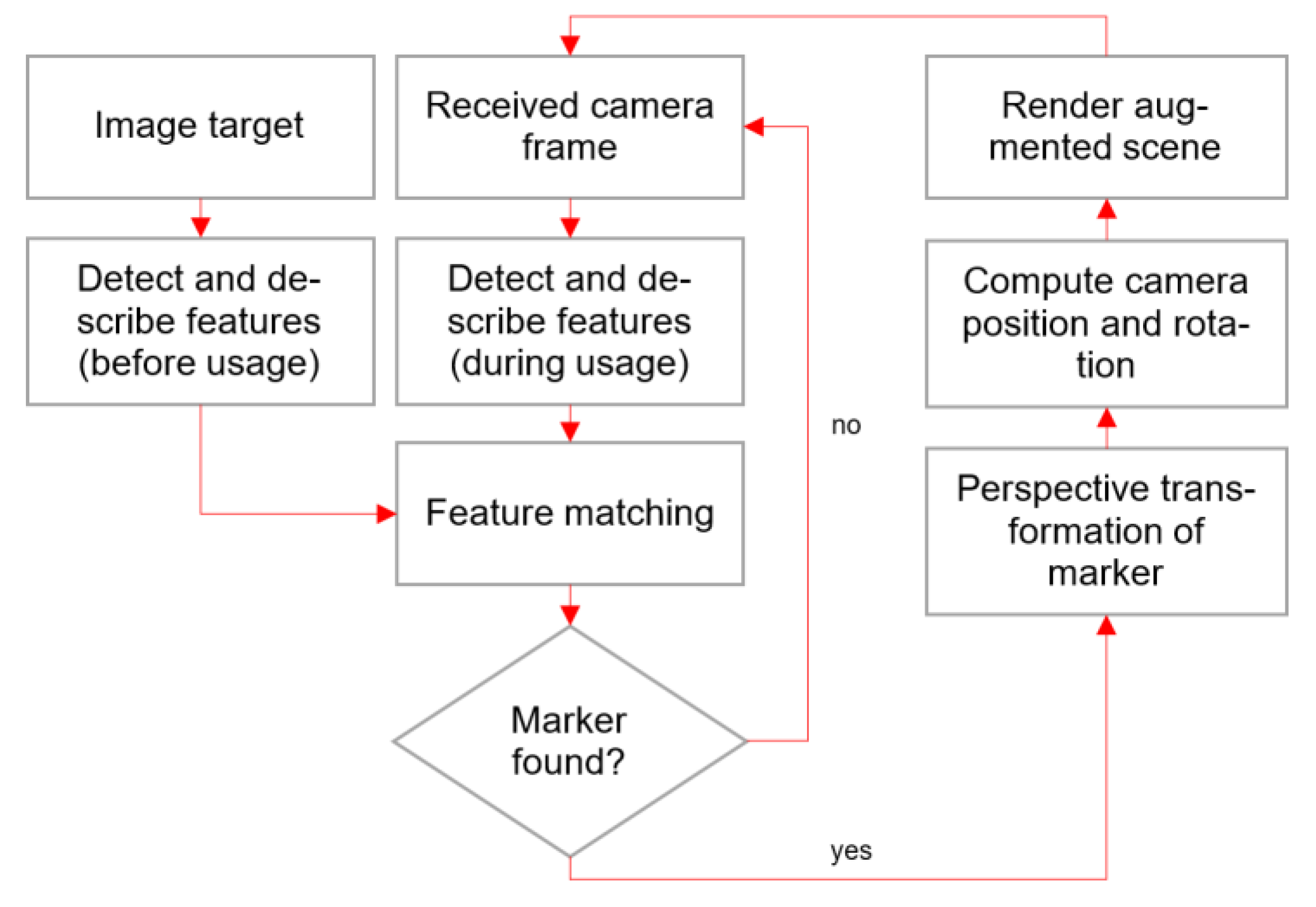
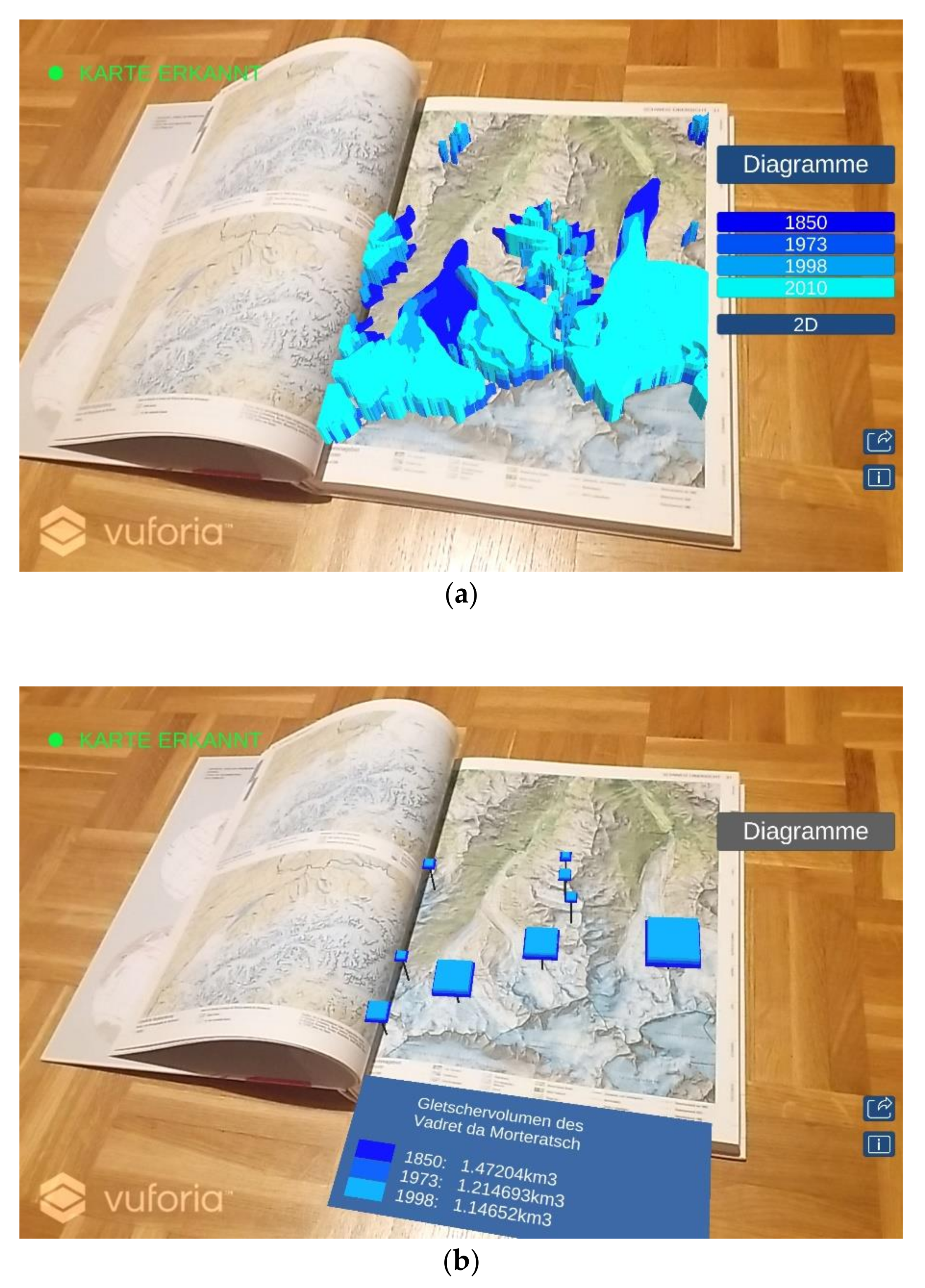
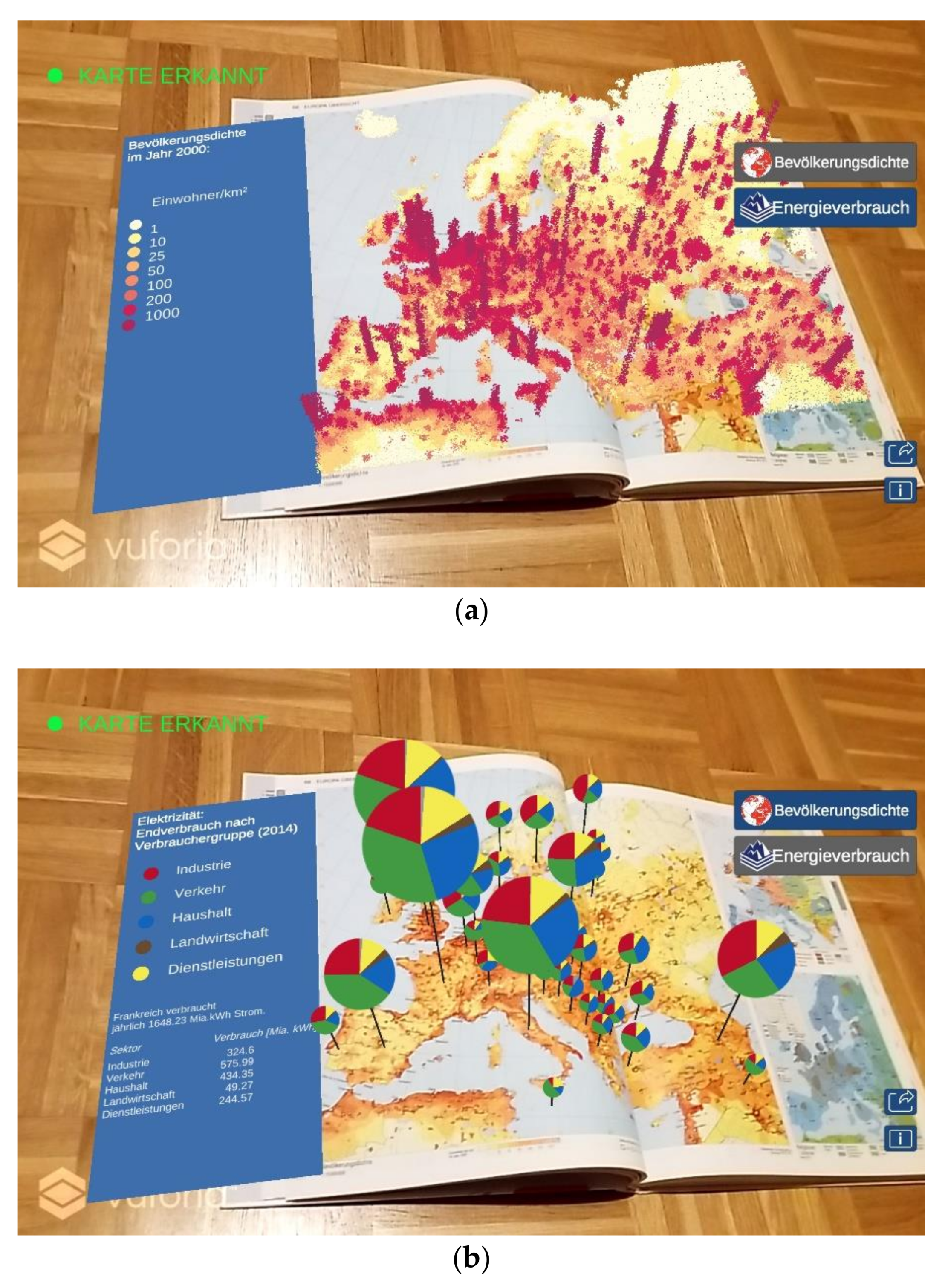
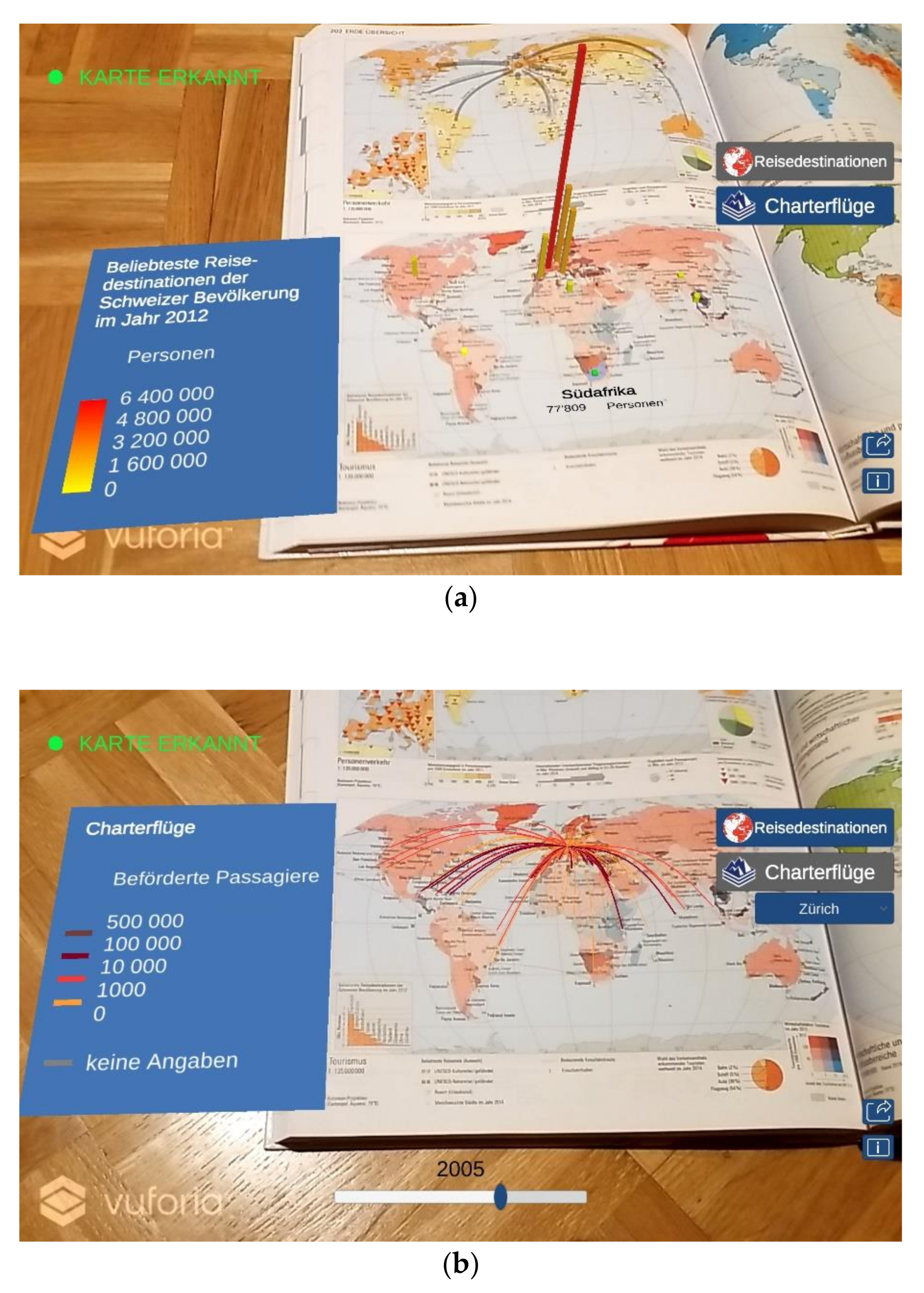
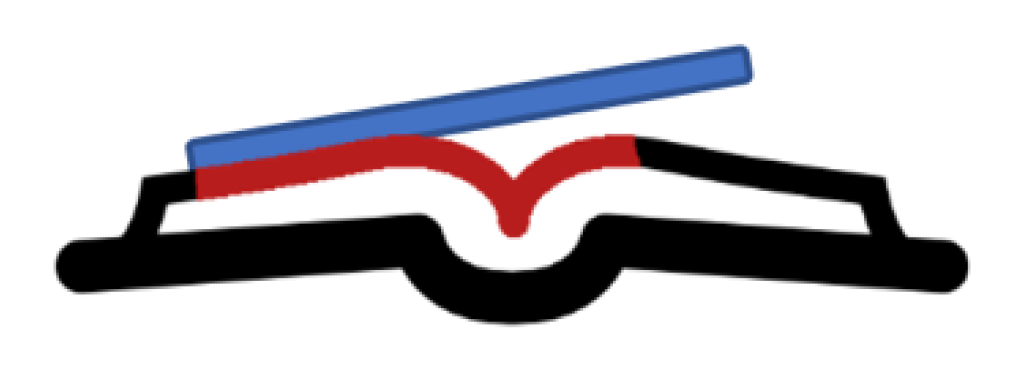
| Atlas Map | Augmented Visualization 1 | Augmented Visualization 2 |
|---|---|---|
| Switzerland > Bernina area (p. 31) | Glacier extent of different years - Polygons (2D), Extruded polygons (3D) | Volume of selected glaciers of the measurement network - Stacked cuboids (3D) |
| Europe > Population density (p. 68/69) | Population density - Dot distribution map (3D) | Electricity: end use by consumer group - Pie charts (2D) |
| World > Tourism (p. 202) | Most popular holiday destinations of Swiss citizens - Bars (3D) | Charter flights: international flight routes from Swiss Airports - Curved lines (3D) |
| P | Map | First Part | Second Part |
|---|---|---|---|
| 1 | Glacier extent | Printed map: T1+Q1 | Augmented map: T2+Q2 |
| 2 | Augmented map: T1+Q1 | Printed map: T2+Q2 | |
| 3 | Printed map: T1+Q1 | Augmented map: T3+Q3 | |
| 4 | Augmented map: T1+Q1 | Printed map: T3+Q3 | |
| 5 | Population density | Printed map: T1+Q1 | Augmented map: T2+Q2 |
| 6 | Augmented map: T1+Q1 | Printed map: T2+Q2 | |
| 7 | Printed map: T1+Q1 | Augmented map: T3+Q3 | |
| 8 | Augmented map: T1+Q1 | Printed map: T3+Q3 | |
| 9 | Holiday destination | Printed map: T1+Q1 | Augmented map: T2+Q2 |
| 10 | Augmented map: T1+Q1 | Printed map: T2+Q2 | |
| 11 | Printed map: T1+Q1 | Augmented map: T3+Q3 | |
| 12 | Augmented map: T1+Q1 | Printed map: T3+Q3 |
| Assessment Tasks | Reflection Questions |
|---|---|
| Effectiveness of map analysis (T1) | Ease of spatial orientation (Q1) |
 | 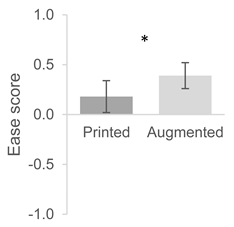 |
| Effectiveness of map interpretation (T2) | Interest in map topic (Q2) |
 |  |
| Attitude from map judgement (T3) | Change of attitude (Q3) |
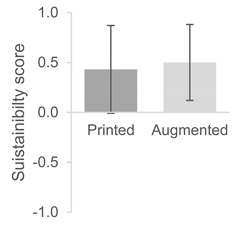 |  |
© 2020 by the authors. Licensee MDPI, Basel, Switzerland. This article is an open access article distributed under the terms and conditions of the Creative Commons Attribution (CC BY) license (http://creativecommons.org/licenses/by/4.0/).
Share and Cite
Schnürer, R.; Dind, C.; Schalcher, S.; Tschudi, P.; Hurni, L. Augmenting Printed School Atlases with Thematic 3D Maps. Multimodal Technol. Interact. 2020, 4, 23. https://doi.org/10.3390/mti4020023
Schnürer R, Dind C, Schalcher S, Tschudi P, Hurni L. Augmenting Printed School Atlases with Thematic 3D Maps. Multimodal Technologies and Interaction. 2020; 4(2):23. https://doi.org/10.3390/mti4020023
Chicago/Turabian StyleSchnürer, Raimund, Cédric Dind, Stefan Schalcher, Pascal Tschudi, and Lorenz Hurni. 2020. "Augmenting Printed School Atlases with Thematic 3D Maps" Multimodal Technologies and Interaction 4, no. 2: 23. https://doi.org/10.3390/mti4020023
APA StyleSchnürer, R., Dind, C., Schalcher, S., Tschudi, P., & Hurni, L. (2020). Augmenting Printed School Atlases with Thematic 3D Maps. Multimodal Technologies and Interaction, 4(2), 23. https://doi.org/10.3390/mti4020023





